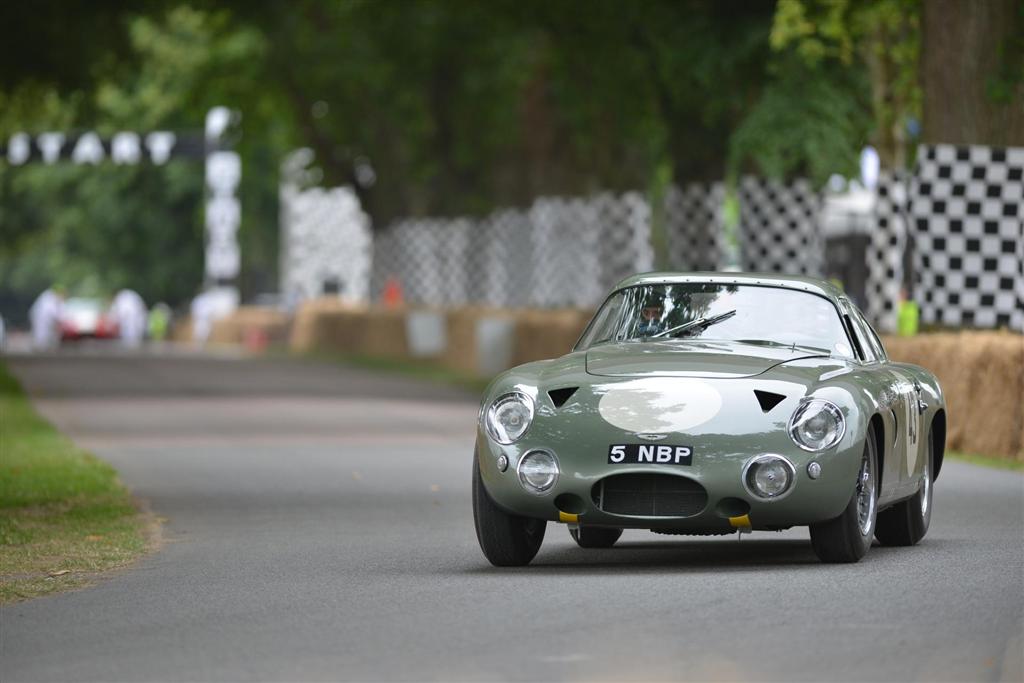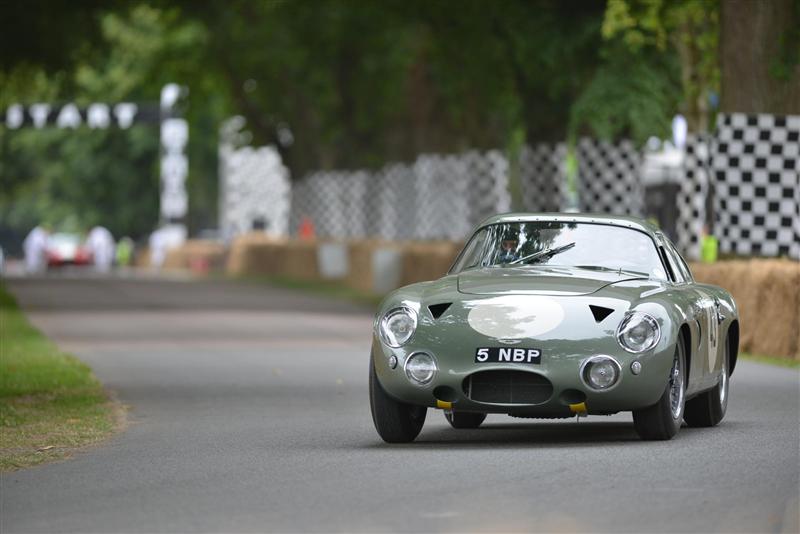Image credit:
Between 1959 and 1963 there were 75 examples of the DB GT with coachwork by Touring created. The DB4 sports car had been introduced at the 1958 London Motor Show with the GT version introduced the following year at the same show. It had been proved in competition earlier that year when the prototype 'DP/199' driven by Stirling Moss won its first race at Silverstone.
The Aston Martin DB4GT, a shortened and lightened version of the DB4. The GT is distinguished from the DB4 by an enlarged air scoop and faired in headlights. Modifications to the GT included 5-inches off the standard wheelbase and the rear seats were replaced with a luggage platform. There was lighter, 18-gauge bodywork. All these changes helped reduce the car by around 200 lbs. It was one of the first cars to go from zero-to-one hundred miles per hour and to stop again in under 30 seconds. The DB4 was also the first to be built at the company's Newport Pagnell works in Buckinghamshire, England.
The engine received much attention. When equipped with a twin-plug cylinder head and triple Weber 45DCOE carburetors, it produced just over 300 bhp at 6,000 RPM. This was a significant increase over the standard 240 BHP engine. Girling were used to bring this performance monster to a stop. There was a choice of five rear axle ratios and a Power Lok limited slip differential.
The front end of the car had faired-in headlamps with Perspex covers. The rear screen and quarter windows also were made of Perspex on many examples. Wind-down windows were frame-less within the doors. Sitting atop the rear wings were twin, quick-release, Monza competition fuel over-fillers. This led to a 30-gallon fuel tank mounted flat in the trunk, which it shared with the spare wheel. The GT cars came standard with lightweight Borrani 42-spoke wire wheels with alloy rims and three-eared 'Knock-offs.'
The interior featured Connolly leather upholstery and Wilton carpeting. The instrumentation cluster had the addition of an oil temperature gauge.
In competition, the DB4 GT, campaigned by the Works team and John Ogier's Essex Racing Stable enjoying numerous victories. In the capable hands of drivers such as Roy Salvadori, Stirling Moss, Jim Clark and Innes Ireland, the DB4 GT often set the pace of the race.
At Le Mans in 1960, Aston Martin had high hopes for their DB4 GT cars. Unfortunately for them, the Ferrari 250 GT SWBs took the first five places in their class. Obviously, more work was required to make the DB4 GT's even more competitive.
Italian Coachbuilder Zagato of Milan was commissioned to design and build 19 examples of the DB4 GT which would be used to compete against the Ferrari 250 SWB Berlinetta Coupes in international competition. The Zagato-built DB4 GT's were lighter and better prepared for racing, but were still unable to beat the Ferraris.
For 1962, Aston Martin began work on a new version of the DB4 GT which would compete under the new four litre prototype rules. It was called the DP212 and was the first of four 'project cars' produced by Aston Martin. The DP212 was lighter and used more aluminum for the chassis when compared with the DB4 GT. It was given a completely new body. Under the bonnet, the engine was bored out and the compression was increased. Horsepower was in the neighborhood of 345 BHP. In the back of the car was a DeDion suspension setup.
At LeMans, the DP212 arrived with very little test and development time under its belt. It had stiff competition, again from Ferrari, who had converted one of their 250 TR racers to comply with the new regulations, resulting in the 330 TRI/LM.
Richie Ginther and Graham Hill were given driving duties for the DP212. At the start of the race, the DP212 quickly showed its potential by leading the field. But the race is a long and grueling event; the DP212 lost precious time with small problems and was later forced to retire after a piston broke. Ferrari would finish the race and capture the checkered flag.
The DP212 had shown that it was capable of winning, or at least competing for podium finishes. Three new cars were built for 1963. Two DP214 models were built for the GT class and a single DP215 was built to contest the overall victory. Powering the GT cars were a 3.7 liter version of the Aston Martin straight six. The DP215 had a slightly larger engine.
The DP214 cars made their racing debut at LeMans where they both were forced to retire prematurely due to piston problems. The cars were fixed and continued to compete throughout the remainder of the season with victories being earned at Monza and Monthlery. At the close of the season, Aston Martin ended the program and both cars were sold to the Dawnay Racing Team. The cars continued to race, with minor victories being achieved. One example was nearly destroyed in an accident at the Nürburgring and was later scrapped. The only example to remain is chassis number 0194.By Daniel Vaughan | Jul 2013
The Aston Martin DB4GT, a shortened and lightened version of the DB4. The GT is distinguished from the DB4 by an enlarged air scoop and faired in headlights. Modifications to the GT included 5-inches off the standard wheelbase and the rear seats were replaced with a luggage platform. There was lighter, 18-gauge bodywork. All these changes helped reduce the car by around 200 lbs. It was one of the first cars to go from zero-to-one hundred miles per hour and to stop again in under 30 seconds. The DB4 was also the first to be built at the company's Newport Pagnell works in Buckinghamshire, England.
The engine received much attention. When equipped with a twin-plug cylinder head and triple Weber 45DCOE carburetors, it produced just over 300 bhp at 6,000 RPM. This was a significant increase over the standard 240 BHP engine. Girling were used to bring this performance monster to a stop. There was a choice of five rear axle ratios and a Power Lok limited slip differential.
The front end of the car had faired-in headlamps with Perspex covers. The rear screen and quarter windows also were made of Perspex on many examples. Wind-down windows were frame-less within the doors. Sitting atop the rear wings were twin, quick-release, Monza competition fuel over-fillers. This led to a 30-gallon fuel tank mounted flat in the trunk, which it shared with the spare wheel. The GT cars came standard with lightweight Borrani 42-spoke wire wheels with alloy rims and three-eared 'Knock-offs.'
The interior featured Connolly leather upholstery and Wilton carpeting. The instrumentation cluster had the addition of an oil temperature gauge.
In competition, the DB4 GT, campaigned by the Works team and John Ogier's Essex Racing Stable enjoying numerous victories. In the capable hands of drivers such as Roy Salvadori, Stirling Moss, Jim Clark and Innes Ireland, the DB4 GT often set the pace of the race.
At Le Mans in 1960, Aston Martin had high hopes for their DB4 GT cars. Unfortunately for them, the Ferrari 250 GT SWBs took the first five places in their class. Obviously, more work was required to make the DB4 GT's even more competitive.
Italian Coachbuilder Zagato of Milan was commissioned to design and build 19 examples of the DB4 GT which would be used to compete against the Ferrari 250 SWB Berlinetta Coupes in international competition. The Zagato-built DB4 GT's were lighter and better prepared for racing, but were still unable to beat the Ferraris.
For 1962, Aston Martin began work on a new version of the DB4 GT which would compete under the new four litre prototype rules. It was called the DP212 and was the first of four 'project cars' produced by Aston Martin. The DP212 was lighter and used more aluminum for the chassis when compared with the DB4 GT. It was given a completely new body. Under the bonnet, the engine was bored out and the compression was increased. Horsepower was in the neighborhood of 345 BHP. In the back of the car was a DeDion suspension setup.
At LeMans, the DP212 arrived with very little test and development time under its belt. It had stiff competition, again from Ferrari, who had converted one of their 250 TR racers to comply with the new regulations, resulting in the 330 TRI/LM.
Richie Ginther and Graham Hill were given driving duties for the DP212. At the start of the race, the DP212 quickly showed its potential by leading the field. But the race is a long and grueling event; the DP212 lost precious time with small problems and was later forced to retire after a piston broke. Ferrari would finish the race and capture the checkered flag.
The DP212 had shown that it was capable of winning, or at least competing for podium finishes. Three new cars were built for 1963. Two DP214 models were built for the GT class and a single DP215 was built to contest the overall victory. Powering the GT cars were a 3.7 liter version of the Aston Martin straight six. The DP215 had a slightly larger engine.
The DP214 cars made their racing debut at LeMans where they both were forced to retire prematurely due to piston problems. The cars were fixed and continued to compete throughout the remainder of the season with victories being earned at Monza and Monthlery. At the close of the season, Aston Martin ended the program and both cars were sold to the Dawnay Racing Team. The cars continued to race, with minor victories being achieved. One example was nearly destroyed in an accident at the Nürburgring and was later scrapped. The only example to remain is chassis number 0194.By Daniel Vaughan | Jul 2013
No auction information available for this vehicle at this time.
Recent Sales of the Aston Martin DP214
(Data based on Model Year 1963 sales)
Aston Martin DP214s That Failed To Sell At Auction
1963 Aston Martin DP214's that have appeared at auction but did not sell.
| Vehicle | Chassis | Event | High Bid | Est. Low | Est. High |
|---|
Vehicles With Comparable Market Values
Similar sales to the range.
1963 Aston Martin DP214
• Additional valuation insight and sales data• History
• Specifications
• Image gallery
• Other Aston Martin DP214 model years

